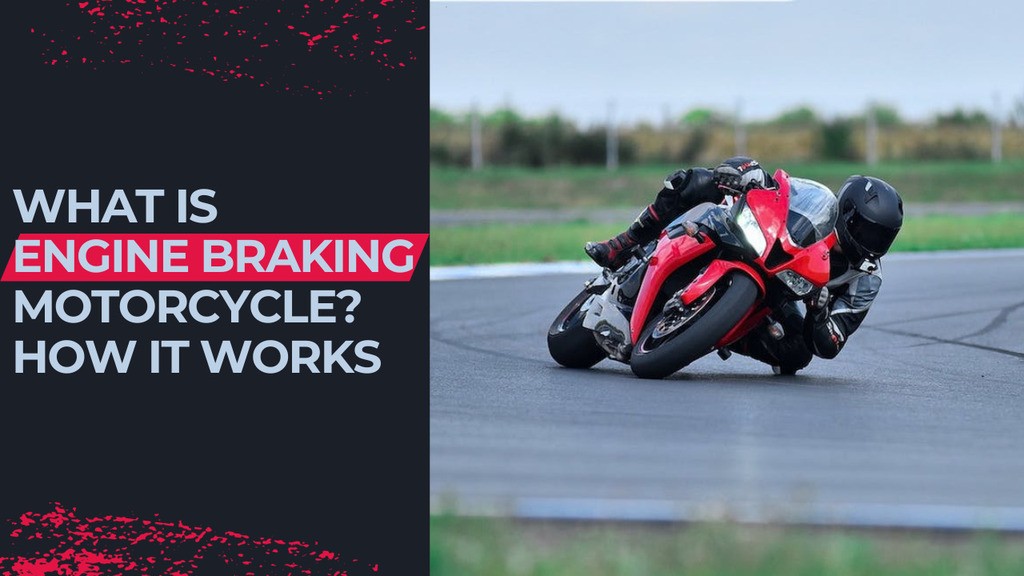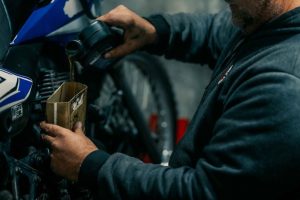You must’ve felt that bike engine pulled when wrapping the throttle closed, but do you understand what’s happening beneath your hands? Engine braking is more than just a way to slow down—it’s a precise technique used by champions to beat their competition.
What is engine braking motorcycle? We’ll explore the mechanics of how engine braking works and how you can leverage its power to smooth out your ride. You’ll learn why the pros swear by this ability and how harnessing engine braking can elevate your skills to the next level.
What Is Engine Braking Motorcycle?
Have you ever rolled off the throttle while cruising down the highway and felt the pull as your bike started slowing itself down? That sensation you’re feeling is engine braking in action. There’s some cool science behind how it works.
Essentially, when you twist the throttle shut, it cuts off air from flowing into the engine through the carburetor or intake valves. On a four-stroke engine, this leaves less air pushing the pistons down during the intake stroke, creating a partial vacuum inside the cylinders.
Now imagine if you let off the gas while coasting in your car – the engine isn’t connecting to the wheels anymore, so you just rely on friction and gravity to slow you down. On a motorcycle, even without applying the brakes, that vacuum effect from the engine translates into an immediate drag on the rear wheel. It’s like getting an instant boost of braking power just by rolling off the throttle.
The degree of vacuum pulling on the pistons directly corresponds to how quick the engine braking slows you. On a big crotch rocket with 150 horsepower, it can feel like somebody squeezed the rear brake hard! With all that vacuum-powered resistance holding back the crankshaft, your bike bleeds off speed way faster than a bicycle just coasting along.
Some newer bikes with sophisticated electronics actually measure the deceleration rate from engine braking alone. This data helps advanced rider aids like traction control know exactly how much grip is available from the rear tire in different conditions. Pushing the limits of engine braking is a real skill, since too much vacuum could potentially upset the rear end under heavy braking.
The next time you roll off the gas, pay attention to that pulling sensation. That’s the magic of engine braking hard at work, using your motor’s own inertia to slow you down safely without wear on the brake pads.
The Benefits of Engine Braking Motorcycle
Did you know engine braking offers benefits beyond slowing the bike? When engaging the transmission properly, one can leverage the engine itself to better control speed. Discover how tapping into this ability can enhance your rides in unexpected ways.
Slows the Bike Without Using External Brakes
One major plus of engine braking is that it doesn’t put any wear and tear on your external brakes like the front and rear disc or drum pads. Trust me, after a long downhill ride, you’ll be glad you didn’t have to use the regular brakes the whole way!
When engine braking is doing the work of slowing you, your brake pads get to kick back and relax. That preserves their life so they’re fresh and responsive if an emergency braking situation arises.
We’ve all seen videos of bikes locking their rear wheel from braking too hard on a steep decline. Engine braking is a much safer option to manage speed on those long mountain runs.
Controls Speed When Descending Hills
Engine braking is incredibly useful for tapering your speed when heading downhill. Gravity wants to speed you up whether you like it or not, so being able to gently slow yourself with a closed throttle is a real blessing.
Rather than having to drag the brakes the whole way and risk fading them or getting the pads too hot, engine braking provides progressive deceleration.
I’ve ridden bikes that could descend steep grades for ages just by modulating the vacuum with different gears. Talk about control!
Controls Speed into Corners During Racing
The racers use engine braking for a reason – it gives them crisp entry speeds into corners. Being able to smoothly bleed off speed in the braking zone sets the rider up perfectly to hit their turn-in point.
Much like trail braking on pavement, engine braking on the dirt helps pro moto-crossers and enduro riders carry controlled momentum into technical sections. The vacuum effect gives an extra layer of feel that fantastic riders leverage to shave valuable milliseconds off their lap times.
So whether logging miles or pushing the pace, engine braking delivers safety, consistency and performance. It’s no wonder the experts count it as one of their most valuable tools!
How Does the Motorcycle Engine Braking Work?
By now you’ve got the gist that closing the throttle causes vacuum braking, but how exactly does it all shake out under the hood? Time for a quick moto-science lesson.
On a four-stroke engine like most motorcycles use, each cylinder goes through an intake, compression, power, and exhaust stroke in continuous sequence. When the intake valve opens on the intake stroke, air gets sucked into the cylinder.
Now here’s where the magic happens – when you roll off the throttle, it cuts off the airflow entering through the carburetor or throttle body. But the piston is still coming up on its intake stroke, which creates a partial vacuum as the cylinder volume increases.
With the intake port shut but the intake valve open, there’s nowhere for the air to go but out. That vacuum effect essentially “grabs” the piston, resisting its upward movement. This opposition directly translates to slowing rotation of the crankshaft underneath, which then slows rotation of the rear wheel.
It’s a pretty ingenious way to use the engine’s own spinning motion against itself. All without applying the brakes! The harder you close the throttle, the more vacuum you generate and thus the stronger the engine braking effect.
With some practice, you can really feel the progressive pulling or “stacking” of the vacuum as the RPMs wind down between gears. Going easier or harder on the grip modulates how quickly you shed speed. Even trail braking with a slightly open throttle adds an element of finesse. It’s all about developing a delicate touch!
Techniques for Effective Motorcycle Engine Braking
- Pull the clutch and downshift gears one by one
- Release clutch lever gradually to find friction zone
- Rev-match before each gear change for smooth shifts
So now you’ve got the basics of how engine braking works, but to really take your skills up a notch requires nailing down some choice techniques. Follow these steps and you’ll be slicing through gears like a pro in no time.
First things first, get in the habit of pulling in the clutch lever fully before each downshift. This disengages the gears so you can bang through the ratio changes without any nasty grinding noises.
From there it’s all about the clutch hand dance. Drop down one cog at a time so you can really feel the bite of the new vacuum pulling against the rotating assembly. The slower you release that clutch lever back out, the more control you’ll have over how fast you shed speed through each gear.
Here’s the juicy bit – easing the clutch out inch by inch lets you discover your bike’s exact friction point. It’s that sweet spot where the plates just start to grip and drag against each other. Riding it smooth is an art, but it’ll have you feathering on and off the brakes like a ballerina.
And while shifting gears may feel second nature, don’t forget the all-important rev-match either! Blipping the throttle in each lower gear syncs the engine speed to the new ratio. Not only does this result in buttery shifts, but it also keeps you from lugging the motor on deceleration.
Master these techniques and engine braking will feel totally dialed in. Just remember to start slow and focus on developing smoothness over speed. The finesse will come with time and practice, so be patient with yourself!
Mastering the Skill of Engine Braking
Practice Makes You Perfect
To really nail engine braking, Committed practice is key. Start by doing it slowly in safe, empty areas without traffic until you develop intuitive muscle memory and finesse.
Try modulating speed rolls on and off by varying how quickly you close and release the throttle. Pay attention to how your engine note changes with different vacuum levels. The more reps you get feeling subtle throttle inputs, the better integrated it’ll become.
Rolling on and releasing the friction zone is also important to get dialed. Find a straight stretch where you can concentrate solely on clutch control without other distractions. Going through the motions gives your hands and brain experience to draw from later.
Own Those Corners
Once you’ve grooved the fundamentals, it’s time to integrate engine braking into cornering. As you begin braking for a turn, smoothly blip down gears while carefully releasing the clutch.
Trail braking with a very slight throttle opening can help settle the rear as you turn in. Then roll back on for precise drive out of the corner. With repetition, modulating vacuum will feel totally natural in all conditions.
Descend with Confidence
Engine braking is incredibly useful when navigating steep downhill sections of road. Compared to drag braking which can overheat pads, smoothly bleeding off speed in a lower gear is way safer and more controlled.
Rev-matching downshifts lets you consistently meter descent without relying on the rear brake. And knowing your bike’s characteristics means trusting your skills on any terrain. Engine braking mastery breeds composure no matter what you encounter.
Motorcycle Engine Braking Common Concerns
One concern new riders often have is whether engine braking will put undue wear on their bike over time. The good news is, when performed correctly, it’s actually quite gentle on your motorcycle.
As long as you’re rev-matching on shifts and not lugging the engine into the dirt zone, the momentary drag of the vacuum effect isn’t going to cause any more wear than regular riding would. Your gearbox and clutch were engineered to handle much harder sudden accelerations under full throttle after all.
Some signs of improper technique might include screeching noises on upshifts or a strange banging sound under braking. But generally speaking, experienced riders have been engine braking for decades with no ill effects. So relax and don’t be afraid to lean on that motor!
One exception is rarely, some high-strung sport bikes may not be the biggest fans of overzealous blipping or rapid clutch work at stoplight grand prix speeds. Early small-displacement Harleys also had cantankerous tendencies when ridden too roughly.
So feel out your particular ride and don’t expect miracles from an older or less sophisticated machine. With most modern bikes, smooth inputs will serve you well. If things don’t feel quite right though, throttle or clutch work may be the probable culprits.
FAQs About Motorcycle Engine Braking
Is engine braking loud? Will it annoy other drivers?
Engine braking may produce more engine noise as the RPMs wind down, but it shouldn’t be overly loud. Keeping RPMs out of the lower ranges and avoiding lugging the motor will minimize noise. Most other drivers are used to normal engine sounds from motorcycles.
Can I engine brake in lower gears too or just higher gears?
You can engine brake in any gear, but it’s most effective in higher gears where there’s more revs to transform into stopping power. Lower gears may not generate as much vacuum effect. Play around to see what feels best for your riding style and bike.
When should I use engine braking vs regular brakes?
Use engine braking primarily for slowing at a steady pace, like down hills. Save your hydraulic brakes for sharper slowing or stopping, or if you need to override the vacuum deceleration from the engine. Combining both smoothly is an advanced technique.
Will engine braking work the same on a cruiser as a sport bike?
All bikes can engine brake, but styling like a cruiser’s tall gearing may make it feel less pronounced. Develop sensitivity to your specific motorcycle – focus on smooth throttle/clutch rolls to let the engine help rather than relying on vacuum alone.
How can I tell if I’m doing it correctly without any dials?
Focus on feeling for consistent rpm drops under braking, and avoiding any strange noises like banging or screeching. With practice you’ll develop a natural sense for your motorcycle’s responses without needing instrumentation. Smooth, progressive slowing is the key.




